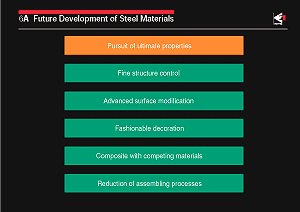The properties of steel as a structural
and functional material have not yet been fully developed, and
there are still a great many possibilities for further development.
Some examples were given in Chapter 1, and the future potential
development of steel materials is outlined below.
Reducing the impurity elements and nonmetallic inclusions to
extremely low levels dramatically improves the ductility, toughness,
fatigue strength, and corrosion resistance of steel. The properties
of high-purity iron have not yet been fully clarified. Clarification
is extremely important since it will provide insights into the
mechanisms governing the various properties of steel, and will
also provide improved properties or clues to the identification
of a new property. Further progress is expected to improve strength,
abrasion resistance, toughness, formability, and electromagnetic
properties by precise control in micrometer to nanometer range
of the grain size, texture, and microstructure. New alloy compositions
or new precipitates may provide the possibility of improving
these properties. In addition, the treatment and processing of
the surface of steel will open the way for new applications with
new functions, such as coloring and decorative properties, in
addition to high corrosion resistance, hardness, lubricity, soiling
resistance, and adhesiveness. Composites of steel and other materials
will progress, resulting in new properties.
Steel serves as the principal material for assembly and processing
industries. In recent years, however, it has become possible
to simplify assembly and processing lines by improvements in
the materials themselves. For instance, (i) precoated steel does
not require painting after processing, (ii) lubricated steel
requires neither oiling during processing nor degreasing after
processing, and (iii) fire-resistant steel does not require heat
insulation by postcoating. In the future, the development of
steel materials will progress so as to accommodate an increasing
demand for recycling in order to preserve resources and energy
and thereby to protect the environment.
In addition to improved properties, it is important to reduce
the variation in quality to the very minimum. Such high levels
of material properties and strict consistency in quality can
be realized by technological progress in the production process.
On the other hand, technological progress is in turn prompted
by the ever-increasing demand for quality and consistency. |
|
 |
 |
 |
|
|